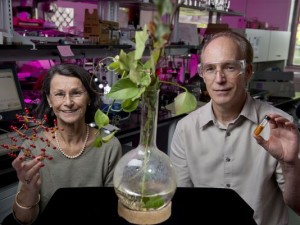
Rutgers researchers Martha Greenblatt (left) and Chalres Dismukes (right) have developed a cost-effective energy storage technology to advance sustainable energy.
Image: Nick Romaneko/Rutgers University
Dan Fatton, ECS Director of Development & Membership services, spotted an article in My Central Jersey that details a potential game changer in sustainable energy.
Researchers from Rutgers University may have just found the key to advancing renewable resources and potentially growing an energy infrastructure based on sustainability.
The researchers from Rutgers’ Chemistry and Chemical Biology Department have recently developed a novel patent-pending energy storage technology grounded in electrochemical science. The new technology is said to not only be cost-effective, but also a highly efficient way to store sustainable energy for later use.
The research published in the journal Energy & Environmental Science addresses the feasibility of widespread utilization of sustainable power.
“We have developed a compound, Ni5P4 (nickel-5 phosphide-4), that has the potential to replace platinum in two types of electrochemical cells: electrolyzers that make hydrogen by splitting water through hydrogen evolution reaction (HER) powered by electrical energy, and fuel cells that make electricity from combining hydrogen and oxygen,” co-author of the study Charles Dismukes explained to My Central Jersey.
The Ni5P4 compound is essential to advancing sustainable energy due to the naturally high abundance of the elements in its makeup.
“Platinum is the benchmark material for both devices, as it has the best conversion efficiency. However, while platinum may be acceptable for making jewelry and low volume specialty applications, it is too expensive for large-scale applications, such as energy storage and conversion. Our new HER catalyst, Ni5P4, has the strong potential to overcome this challenge,” said Dismukes.
The Ni5P4 is expected to lower materials costs for both electrolyzers and fuel cells, all while maintaining or even boosting energy efficiency.
Take a look at Dismukes and Greenbaltt’s abstract to be presented at the 227th ECS Meeting, entitled “Understanding the Influence of Structure on Activity and Stability in the Catalysis of the Oxygen Evolution Reaction (OER) Using Crystalline Oxides As a Platform“.
Additionally, the Rutgers researchers are partnering with Proton OnSite and the Solar Fuels Institute (SOFI) of Telluride, CO to create a public display that highlights the production of renewable liquid fuels using only sunlight, water, and carbon dioxide.
Proton OnSite, the winners of the Industrial Electrochemistry & Electrochemical Engineering Division New Electrochemical Technology (NET) Award, will also make a presentation at the 227th ECS Meeting in Chicago.
To learn more about electrochemistry’s impact on sustainable energy, check out the ECS Podcast featuring the National Renewable Energy Laboratory’s John A. Turner. (Free to download!)
And make sure to attend the 227th ECS Meeting where Turner will give the ECS Lecture entitled “Hydrogen from Photoelectrochemical Water Splitting – What’s it gonna’ take?“.


